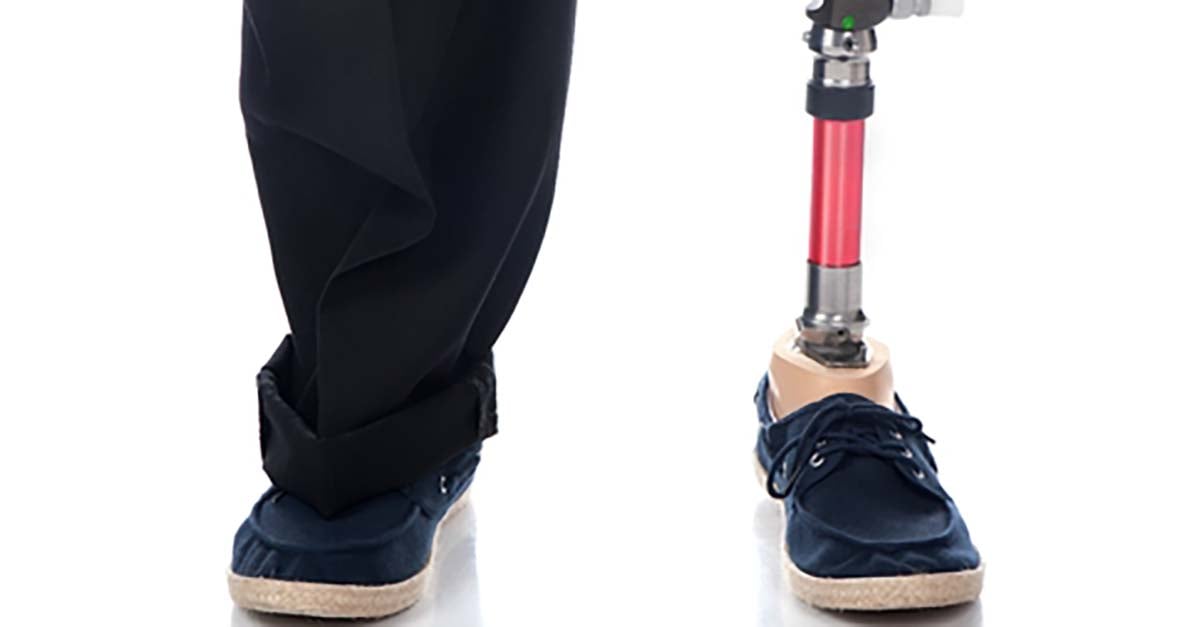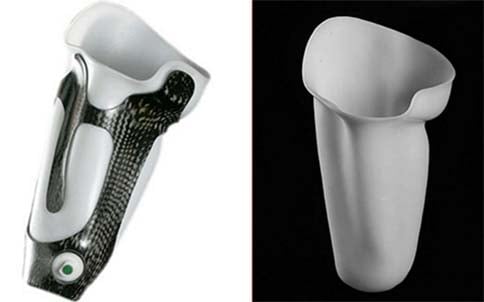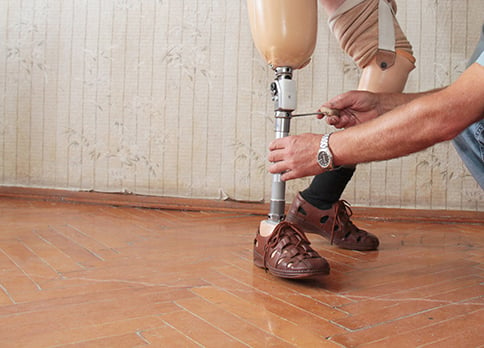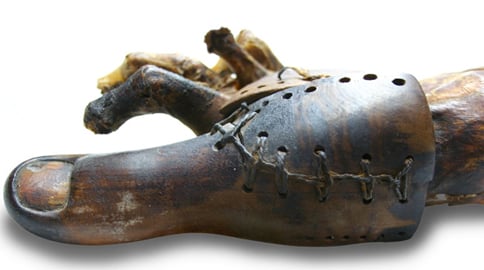#1: Ash’s Chainsaw Hand in Evil Dead 2
This over-the-top prosthetic device that replaces Ash’s hand is delightfully unbelievable -- and even more delightfully handy when it comes to killing hordes of undead. We’re not totally sure how practical it’d be in everyday life, unless you were a lumberjack, in which case it might make you the most efficient lumberjack in the world!
#2: Edward Scissorhands’ … Well, Scissor Hands, in Edward Scissorhands
Coming in a very close second to the chainsaw are the twin collections of rusty blades Edward uses as hand prostheses in the movie Edward Scissorhands. They might seem a bit hard to control, but Edward manages to make them look downright graceful, especially when he’s ice-sculpting.
#3: The Captain’s Hook in Hook
You had to see this one coming! There might not be a more famous prosthesis in the world than Captain Hook’s famed hook-hand. What’s more, there might not be a catchier prosthesis-themed title than Hook. Again, it might not be the most practical hand prosthesis ever (how in the world do you grip things?), but Hook’s hook is certainly a cultural icon.
#4: Mr. Igoe’s Entire Wardrobe of Hands in Innerspace
When one hand prosthesis just won’t do, the only option is to have a whole collection of them. Mr. Igoe has a wide variety of hands to choose from, including one that shoots bullets and another that doubles as a flamethrower. The possibilities are endless!
#5: Wolverine’s Claws in X-Men
Okay, this might be a bit of a stretch as far as the word “prosthesis” goes, but Wolverine’s retractable claws are the definition of awesome! They’re easy to stow away when you don’t need them (although it can’t exactly be comfortable to have ten-inch blades lodged somewhere inside your forearm), they’re basically indestructible, and they’re the clear winner when it comes to dropping jaws.
Need a Functional Upper Extremity Prosthesis? Call BioTech!
Listen, we’d all like to be Wolverine, but when it comes to real-life hand prostheses, retractable claws aren’t as cool as they look!
If you're in need of an upper extremity prosthesis (or any other prosthesis), BioTech is the place for you. We offer pre-amputation consultations, immediate postoperative prostheses, and expedited fittings for out-of-town patients -- plus so much more. Contact us today!
So you think you know a lot about prosthetic devices, do you? From fingers to legs to arms, there certainly is a lot to know! Check out our collection of fun facts about prostheses and see if your knowledge matches up with ours!
Q: What does the word “prosthetic” mean?
A: “Prosthetic” is a Greek word that means “addition.” Pretty appropriate, huh?
Q: How much do the most expensive prosthetic devices cost?
A: A prosthesis can cost up to $100,000 (but 3D printing may be changing all that). Yikes!
Q: What is the ratio of males to females with amputations?
A: 77% of all amputations are performed on males! This doesn’t take into account people who are born without limbs, though.
Q: What is the top cause of amputations?
A: Most amputations are performed because of cardiovascular disease, diabetes, or other health conditions.
Q: What was the first recorded prosthetic device?
A: It was a big toe on an Egyptian noblewoman! We actually did a blog post about her.
Q: How many people in the United States are amputees?
A: This number may be higher than you expect. 1 out of every 200 people in the United States has had an amputation.
Q: Who is the best company for prosthetic and orthotic devices in the state of Alabama?
A: BioTech, of course! We have all kinds of cool technology to make your prosthesis as comfortable as possible, and we do expedited fittings, too.
BioTech is passionate about helping you live your life to the fullest after limb loss. Who says you can’t be active, energetic, and comfortable? Contact us today for help and advice with your device -- we are dedicated to serving our patients as if they were family!
If you wear a prosthetic limb, you know the prosthetic limb socket is of utmost importance. In fact, in many ways, it is the most important part of your prosthesis. The socket has to fit perfectly in order to give you the comfort and flexibility you need; otherwise, wearing your device will be uncomfortable and impractical.
Read on to find out what makes BioTech’s Comfort Socket so special!
Unique Design
Our transfemoral design is specially made to bring you the highest possible level of comfort and mobility with your prosthesis. Some of the features you’ll find with our Comfort Socket include:
- An increased level of control
- A high level of flexibility to allow for a smooth bending motion
- Relief of discomfort on pressure points
- Reduced socket rotation, which allows for more stability
- A high level of contouring around your residual limb
With these design aspects on your prosthetic limb socket, you’ll feel more comfortable, flexible, and confident than you will with other designs.
Special Advantages
One of the main advantages of the Comfort Socket is the way it is specifically molded to fit your residual limb. No one else’s socket will fit you because each one is made for a particular wearer. This kind of customization gives you a lot of control and proprioceptive feedback.
Additionally, we’ve worked hard to give your pressure points some relief. With the Comfort Socket, the weight-bearing characteristics have been equalized, which means any bony sections of your residual limb won’t be subject to high pressure. All of this helps prevent swelling and maintains proper circulation, resulting in even more comfort for you!
Looking for a Better Prosthetic Limb Socket? Look No Further!
At BioTech, your comfort and satisfaction are our top priorities. What better way to deliver those things than with our Comfort Socket? If we can give you a high level of mobility and a perfect socket fit, then we know we have done our job well. If you have questions about our Comfort Socket or you’d like to speak with us about a fitting, contact us today! We are always here to help!
The first prosthetic limbs ever created seemed like a miracle. People who hadn’t been able to walk for years -- or maybe ever -- suddenly had a new leg. And people who had only been able to use one hand could now use both. A miracle indeed -- but of course, these early prostheses were just the beginning.
Technology has continued to push forward, and here we are today in the world of 3D printing. With this kind of advanced manufacturing, prosthetic limbs have become less expensive and faster to make, which obviously has the potential to change the entire industry. But how, exactly, can someone produce a 3D printed prosthetic limb? Read on to find out!
What Is 3D Printing?
The first question you may ask is what, exactly, we mean by “3D printing.” The words are familiar individually, but when you put them together, the mind boggles a little. Basically, 3D printing is the process of using digital files to create solid, three-dimensional products. It’s sometimes called “additive manufacturing” because of the way it builds layers of material on top of each other until the final object is completed.
People who design 3D printed objects must begin by creating a virtual design of the object using a 3D modeling program in a CAD (Computer Aided Design) file. Then, the software slices the final model into hundreds or thousands of horizontal layers. This file is uploaded to the 3D printer, which begins to “print” one layer at a time in succession until all the layers have been added and the product is complete. The layers are fused together seamlessly so that the naked eye cannot tell that they weren’t originally a single piece.
How Can This Benefit Prosthetic Limbs?
There are five main ways 3D printing can benefit the prosthetic limbs industry.
#1: Speed
While regularly-made prosthetic limbs can take weeks or months to produce, a 3D printed prosthetic limb can be made in a day.
#2: Ease of Customization
With traditional prostheses, high levels of customization can cost a fortune. But 3D printed prosthetic limbs can be easily customized to perfectly suit the wearer and his or her lifestyle.
#3: Growth
Children outgrow prosthetic limbs quickly, which can be hard on the old bank account (who can pay $10,000 to replace a prosthesis every year or so?). Unfortunately, insurance often hesitates to cover prosthetic limbs for children because they know they will outgrow them and will need another one soon. But with 3D printing, production is so much easier and cost-efficient that it’s not a big deal to replace a prosthetic limb every year for a growing child.
#4: Cost
Typically, a prosthetic limb can cost anywhere from $5,000 to $50,000. But 3D printed prosthetic limbs can cost mere hundreds of dollars -- and sometimes even less than that!
#5: Comfort
A big issue for people with limb loss is their prosthetic socket feeling uncomfortable. There is research underway for the design of a more comfortable 3D printed socket, but fortunately, BioTech has an amazing Comfort Socket that you should definitely check out. The socket is perhaps the most important part of your prosthesis because it is the part that touches your residual limb. It should be comfortable!
Contact BioTech Today!
If you’re looking for passionate, knowledgeable professionals to help with your prosthetic limb fitting or to show you how great the Comfort Socket really is, contact us today! We are always here to help you, and we treat you like family.
After you’ve lost a leg, it’s normal to want to be fitted for a prosthesis and learn how to walk on it as soon as possible. But it’s important to remember that learning to walk with a prosthesis is a brand new skill you’re going to acquire, which means it’ll take a little time! It may be several months before you gain the strength and coordination you’ll need to use your prosthesis on a daily basis.
Keep reading to learn what is involved in this process and what you should expect from yourself, your new leg, and the entire experience.
Fit Is Key
As you’re being fitted for your new leg, remember that this is one of the most -- if not the most -- important part of the process! A comfortable, secure fit between your residual limb and the socket of your prosthesis is essential for successful daily use.
Proper maintenance also affects the way your prosthesis fits. Clean the socket regularly so your skin won’t get irritated, and be sure to take the weather into account as you venture outside.
Bearing Weight
After your prosthesis has been expertly fitted to your residual limb, you’ll be ready to start transferring some weight onto it. This is a crucial part of learning how to walk again. For many people, this is the hardest part of the whole experience because they’re not confident enough to put all their weight on the prosthesis as they walk.
One way to gain confidence is by using parallel bars and supporting your bodyweight with your arms. Soon, you’ll be able to use only one arm to support your weight, and you’ll begin to put more and more weight on your prosthesis as time goes by. If your leg was lost above the knee, you’ll have the additional challenge of learning to walk with an artificial knee joint -- but the process is essentially the same. You’ll bear more weight on your prosthesis each day until finally, you’re walking all by yourself!
Walking Successfully
Once you’ve begun walking on your own, make sure you continue to use any aids recommended by your doctor or therapist. The last thing you want to do is take it too fast and end up hurting yourself!
As you’re walking in everyday situations, you’ll encounter things that will challenge you, like stairs, curbs, and uneven surfaces. Take it slow and let your therapist help you learn to navigate these various terrains. There is no rush! Be sure to give yourself the time and space you need to get comfortable with all of this. It won’t be an instant result, and that’s okay.
Contact BioTech for Prosthesis Information
There are many more tips we could give you about learning to walk with a prosthesis! Contact us if you have questions, worries, or if you simply need a knowledgeable professional to help you get started walking again. We are here for you!
Exercise might be a bit of a challenge after limb loss, but ultimately, the choice is yours: will you let limb loss dictate your fitness routine, or will you rise to the occasion and keep your body in top condition, no matter what?
Below, we’ll talk about some ways to maintain your fitness with a prosthetic limb. Read on!
Begin at an Appropriate Level
When you think about it, exercise for someone who has all four limbs really isn’t that different than exercise for amputees. In each case, the person who is starting an exercise program needs to recognize their abilities and their obstacles, and they must start -- and continue -- exercising at the correct level for their physique. If they do too much, they risk injury; if they do too little, the program will ultimately be ineffective.
Someone who wears a prosthesis must begin their workout program at an appropriate level of challenge just like anyone else. The only difference is adapting to a mechanical device that wasn’t there before, which, admittedly, is a different sort of challenge than the kind that someone with all four limbs might face. But if it’s treated as part of the fitness routine, and the person who is exercising chooses to “get used to” the device just as they will get used to the physical demands of their exercise, they may be shocked at how much success they find.
Recognize the Benefits
Just like people without limb loss, amputees will see myriad benefits from engaging in an exercise program. Some of these benefits include:
- Improved functioning of heart, lungs, and muscles
- Better flexibility, mobility, and coordination
- Prevention of limb atrophy and muscle hypertrophy
- Stress management
- Overall sense of well-being
- Improved self-esteem
- Better sleep
Although many people with limb loss are fearful of hurting themselves, feeling uncomfortable, or being scrutinized while exercising in public, the fact is that the benefits far outweigh the possible risks.
Yes, exercise for amputees can be very demanding -- but with a little determination and the help of a fitness professional, anyone can reap the rewards of better physical, emotional, and mental health!
Become Empowered with BioTech!
Exercise for amputees isn’t just about physical fitness or mental health. It’s about setting a challenge for yourself and overcoming it. It’s about finding your inner strength -- that deep-rooted power you may not even know is there. And once you’ve discovered it, you’ll realize the only limits you really have are the ones you place on yourself.
BioTech can help you discover your inner power! Contact us today for help with prosthetic limbs, expedited fittings, and expert advice. We are here to help!
Get ready for sand and surf, because summer is upon us! If you’re planning to head to the beach this year, or even if you’re just going to stick around the house, you may have concerns about how your prosthesis will hold up in the heat. Rest easy! We have some great advice for successfully wearing a prosthesis in the summer.
(Your skin may need some extra attention this summer, too!)
Sweat and Swelling
As the mercury rises, two things may affect the fit of your prosthesis: increased sweat production and the swelling of your residual limb. We all know that a poorly-fitting prosthesis isn’t any fun, so what can you do to prevent or help this situation?
Call your prosthetist to discuss your summer plans. He or she may be able to make a few adjustments to your device that will reduce the effects of swelling and sweating, and provide you with more comfort during these hot months.
Sand and Water
Headed to the beach with friends or family? Awesome! Just be sure to watch out for the possibly harmful effects of sand and water on your prosthesis. Water may sneak into the mechanical parts of your prosthesis and cause rust -- not to mention possibly put your warranty in danger. Sand may also get into the same places and cause poor functionality.
To reduce the risk of sand damage to your prosthesis, cover it up (especially the mechanical parts) with a socket cover. As for water damage, the best option is to swim without your prosthesis, which also gives your residual limb some breathing room. If you need your prosthetic device in order to swim, consider a waterproof or water resistant option that will give you the protection you need during your aquatic activities.
Wearing a Prosthesis in the Summer Is Easy with BioTech!
Whether you’re headed to the beach, the mountains, or your couch, BioTech can help you enjoy the summer to its fullest. Contact us today!
Scoliosis, a medical condition in which the spine takes on a sideways curvature, most often occurs during a child’s growth spurt just before they enter puberty. While some causes of scoliosis can be attributed to cerebral palsy and muscular dystrophy, most causes are unknown.
Read on for more information about this condition, plus treatment options in the form of scoliosis braces for children.
What Are the Risks?
While most scoliosis is mild, it is possible for some children to develop spinal curvature that worsens with time. In fact, it can even become disabling. If the abnormality becomes severe, it can decrease the amount of space inside the chest cavity and make normal lung function difficult.
A child with scoliosis should be closely monitored through the use of X-rays to check the status of the curvature. In some cases, the child may not need treatment at all. But other children may require the use of a back brace or even surgery.
No matter when a child is diagnosed with scoliosis, it is important to seek treatment as soon as possible. Early intervention can allow the child to live a full, normal life. Fortunately, scoliosis braces for children are available -- and BioTech can help you walk through the process of choosing the correct brace and getting the very best results possible.
When Should You Get a Brace?
Typically, unless there are extenuating circumstances, doctors will only recommend scoliosis braces for children if the spine curvature is greater than 25 degrees. If the curvature is less than this, but is progressing to a higher degree, then a brace may be recommended as well.
If the scoliosis is discovered early and the child begins treatment as soon as possible, a brace can be a very effective way to stop the curvature from getting worse.
Types of Scoliosis Braces for Children
Two options of bracing treatments offered here at BioTech are the underarm (or low profile) brace and the Providence Nocturnal Scoliosis System.
An underarm brace is custom-fitted and molded for the child’s specific measurements so that curvature progression is restricted as much as possible. Most underarm braces can be worn under clothing. Typically, they are worn for 20-23 hours per day.
The Providence Nocturnal Scoliosis System is designed to be worn at night. As a hyper-corrective orthosis, this brace can treat scoliosis without interfering in daytime activities -- a major plus for older kids.
Questions? Contact BioTech Today!
If you’re ready to learn more about scoliosis braces for children, contact BioTech today. We are ready and willing to help!
Today’s prosthetic devices are nothing short of extraordinary. With modern developments like carbon technology, your prosthesis is lighter and more functional than ever before! However, this wasn’t always the case. Limb loss isn’t a new thing, and neither are prosthetic devices -- so what did people do centuries ago? What kinds of prostheses did they wear? Let’s take a look!
The Earliest Prosthesis
From what we can tell, the earliest example of a prosthetic device was -- wait for it -- a toe! Specifically, it was a big toe, and it belonged to an Egyptian noblewoman between 950 and 710 BC.
It’s a bit surprising that the first prosthesis was something as seemingly insignificant as a big toe, and not something more substantial, like an arm -- but the thing about Egyptian culture back then was that they were very concerned about wearing their sandals. If you were going to wear traditional Egyptian thong sandals (and anybody who was anybody was wearing them, of course), then you needed your big toe!
For this woman, wearing a prosthetic toe was as much about function as it was about her identity as an Egyptian and a noblewoman. If she couldn’t wear her sandals, then she couldn’t be who she was supposed to be -- or so she must have thought.
The Most Famous Early Prosthesis
In the history of prosthetic limbs, the most famous Ancient Roman with a documented prosthesis was General Marcus Sergius.
Sergius lost his right hand in the second Punic War. He was given a prosthesis made from iron that allowed him to properly hold his shield and keep fighting. The loss of his hand occurred very early in his military career, but it didn’t stop him from escaping both times when he was later captured twice by Hannibal.
The Beginning of Modern Developments
It wasn’t until the early 16th century that Dr. Ambroise Paré made great progress in amputation surgery and prosthetic limbs. He was the very first person to develop a prosthetic hand with hinges and a leg with a locking knee joint.
There wasn’t much progress with prosthetic limbs between the 1500s and the 1800s, but there were significant advancements in amputation surgery in the mid-19th century that enabled doctors to shape the residual limb for better attachment of a prosthesis. The limbs themselves weren’t much improved from centuries before, but for people with limb loss, things were starting to go down the right path.
BioTech: Where History Meets Modern Technology
We value the lessons of the past, but we also know that technological progress is vital! At BioTech, we work hard to make sure your prosthesis fits and functions exactly as it should. We won’t give you an iron hand like Sergius, but we will give you a new limb that allows you to live a full, rich life! Contact us today for more information!
Growing up is hard for anyone, but for children with limb loss -- whether they were born without the limb or they lost it at some point in childhood -- getting through school, and just getting through life in general, can be even more challenging. What are some ways that children with limb loss can love who they are and embrace their new life? Let’s take a look!
#1: Remember -- It Will Get Easier!
No matter when a child loses a limb, they face multiple difficulties as they learn to adapt. One of the best things to do is to remember that wearing a prosthesis, or simply living with limb loss, will get easier as time goes on! Eventually, it will stop feeling like such a production and start feeling normal. This isn’t to downplay the seriousness of the loss; it’s meant to give them hope that their life can be full and bright, even after limb loss!
#2: Lead by Example
Most people don’t know how to act around children with limb loss. They may ask too many questions or try to make jokes because they’re nervous. To set them at ease (and ultimately set the child at ease), the child should talk about the subject and about themselves in the way they’d like others to talk about it. Whether this involves humor or seriousness is up to them, but the best way to educate others about how to treat them and their limb loss is to show them firsthand.
#3: Tell Others How to Help
Sometimes, children assume their parents or other family members know how they’re feeling, but this isn’t always the case! Encourage children with limb loss to explain how they’d like to be supported. It may take some prodding, but eventually, they’ll be able to express at least one or two opinions on the matter -- and then their support network will be able to do the very best job possible!
BioTech Is Your Source for Help for Children with Limb Loss
At BioTech, we understand the need to give children specialized treatment and devices, and have developed a suite of services specifically for youth, from infants to adolescents. If you have questions about our pediatric services, contact us today! We’d love to help!









